Why this resume works
- Quantifies accomplishments: Measurable accomplishments, such as managing a $10M budget and negotiating contracts saving $2M annually, highlight the applicant’s financial impact and strategic prowess.
- Highlights industry-specific skills: Administrative skills like inventory optimization and vendor management emphasize the applicant’s fit for supply chain roles.
- Showcases career progression: Progressing from purchasing agent to procurement manager demonstrates increasing responsibility, showcasing growth through positions demanding greater oversight and strategic influence.
More Procurement Manager Resume Examples
See our procurement manager resume examples to learn how to showcase your negotiation skills, supplier relationship management, and strategic sourcing experience. These purchasing resume samples will help you create a resume that highlights your expertise effectively.
Entry-Level Procurement Manager
Why this resume works
- Centers on academic background: By showcasing an MBA in supply chain management, the applicant shows a strong academic foundation, which is important for early career advancement.
- Effective use of keywords: Using role-relevant keywords like “procurement optimization” and “vendor negotiation” ensures the resume aligns well with ATS requirements.
- Shows digital literacy: Skill with ERP systems highlights the applicant’s computer skills, demonstrating readiness for tech-driven roles in modern workplaces.
Mid-Level Procurement Manager
Why this resume works
- Points to measurable outcomes: By outlining achievements like cost reductions and increased efficiency, the applicant paints a vivid picture of their ability to deliver measurable outcomes in procurement roles.
- Includes a mix of soft and hard skills: The resume showcases a balance of technical expertise and interpersonal skills, highlighting abilities in negotiation alongside strategic sourcing and data analysis.
- Demonstrates language abilities: Language skills in Spanish support cross-cultural negotiations and international vendor relations.
Experienced Procurement Manager
Why this resume works
- Showcases impressive accomplishments: Accomplishments like reducing costs by 15% and improving supplier efficiency by 30% reflect standout achievements that align with senior-level performance.
- Emphasizes leadership skills: Managing a $10M procurement budget and leading an ERP implementation illustrates leadership skills, showcasing initiative and strategic oversight.
- Focuses on work history: Using a chronological resume format to highlight progressively senior roles, like procurement manager, emphasizes extensive career experience.
Procurement Manager Resume Template (Text Version)
Olivia Brown
Jersey City, NJ 07307
(555)555-5555
Olivia.Brown@example.com
Professional Summary
Seasoned Procurement Manager with 9 years in strategic sourcing and vendor management. Proven ability to reduce costs and streamline supply chain processes. Expert in budget management and contract negotiation.
Work History
Procurement Manager
Global Supply Solutions – Jersey City, NJ
May 2021 – August 2025
- Managed $10M annual budget for procurement.
- Reduced costs by 15% through strategic sourcing.
- Negotiated contracts saving $2M annually.
Supply Chain Coordinator
Logistics Co. – Maplewood, NJ
May 2017 – April 2021
- Optimized inventory levels, reducing excess by 20%.
- Coordinated with vendors for timely deliveries.
- Streamlined supply chain processes, improving efficiency.
Purchasing Agent
Warehouse Plus – Newark, NJ
May 2016 – April 2017
- Managed purchase orders worth $5M annually.
- Conducted market research to optimize pricing.
- Developed supplier relationships for better deals.
Skills
- Strategic Sourcing
- Vendor Management
- Contract Negotiation
- Budget Management
- Inventory Optimization
- Market Research
- Supply Chain Processes
- Supplier Relationship Management
Education
Master of Business Administration Supply Chain Management
Stanford University Stanford, California
June 2016
Bachelor of Science Business Administration
University of California, Berkeley Berkeley, California
June 2014
Certifications
- Certified Supply Chain Professional – APICS
- Procurement Management Certificate – Institute for Supply Management
- Lean Six Sigma Green Belt – Six Sigma Institute
Languages
- Spanish – Beginner (A1)
- Mandarin – Intermediate (B1)
- French – Intermediate (B1)
Related Resume Guides
Advice for Writing Your Procurement Manager Resume
Dive into our tailored advice on how to write a resume for procurement managers and discover how to highlight your negotiation skills, supplier management expertise, and cost-saving accomplishments.
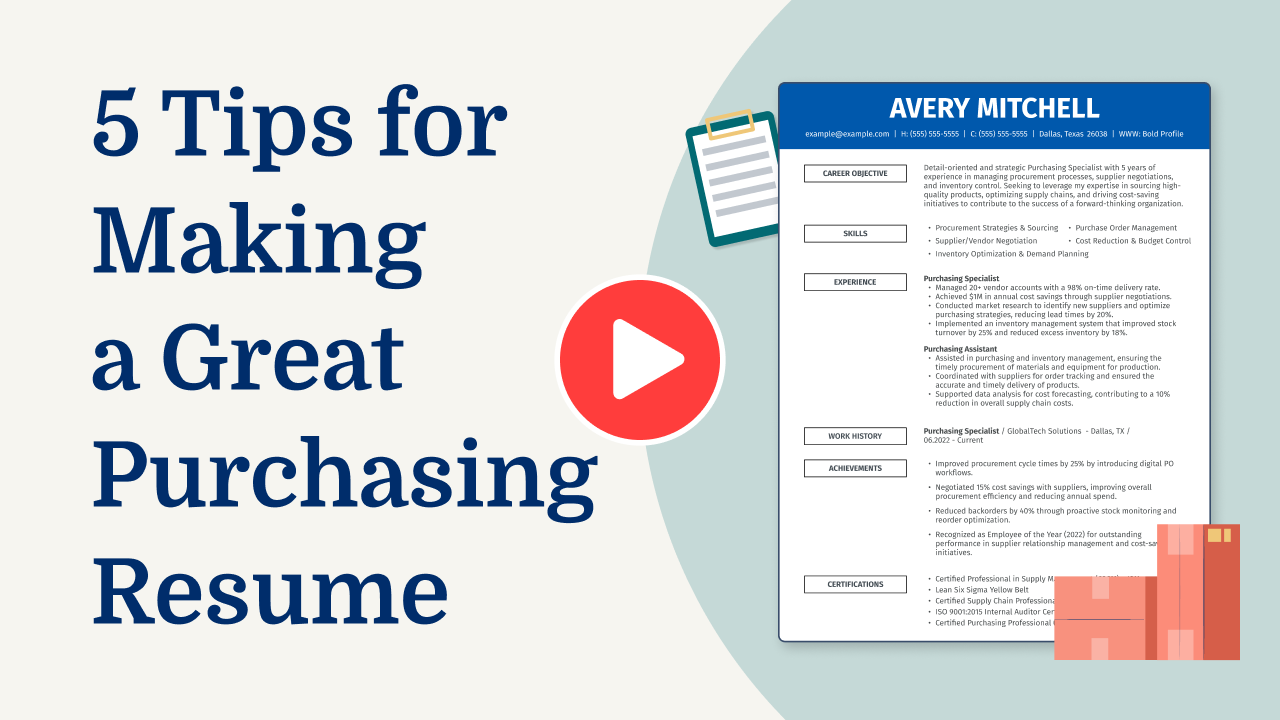
Highlight your most relevant skills
Listing the right skills on your resume is key to proving you’re a strong candidate for a procurement manager role. By combining a clear skills section with strong examples of your experience, you’ll present yourself as a well-rounded professional ready to handle the challenges of procurement management.
A dedicated skills section makes it easy for employers to see your strengths at a glance, whether that’s negotiating contracts, managing supplier relationships, or understanding supply chain logistics.
Be sure to balance technical expertise with interpersonal abilities like communication and teamwork to give a complete picture of your capabilities.
To make an even greater impact, highlight these skills in your work experience. Instead of just listing them, show how you applied them in past roles.
For example, mention how your negotiation skills led to cost savings or how your analytical approach improved purchasing efficiency. This not only demonstrates that you have these skills but also proves you’ve used them to deliver real results.
For procurement managers, a resume format that highlights cost-saving strategies, vendor management skills, and negotiation successes is ideal.
Showcase your accomplishments
When organizing your work experience as a procurement manager, start with the most recent position and work backward. For each job, include the job title, employer name, location, and employment dates. This reverse chronological order helps employers quickly see your career progression and relevant experiences.
To make your resume stand out, focus on achievements rather than just listing duties. Quantifying accomplishments can make them more compelling. For example, mention how you reduced costs by 15%, saved time by streamlining processes, or improved supplier efficiency.
Turning duties into achievements involves highlighting measurable outcomes. Instead of saying you managed vendor relationships, say you negotiated contracts that resulted in a 20% cost reduction over two years. Use strong action words like “developed,” “implemented,” or “led” to describe what you’ve done and the impact it had.
These detailed accomplishments help hiring managers understand your skills and contributions at a glance. By effectively showcasing how you made a difference in past roles, you’ll demonstrate your value as a procurement manager to potential employers.
5 procurement manager work history bullet points
- Negotiated and secured contracts with suppliers, resulting in a 25% cost reduction over two years.
- Streamlined procurement processes by implementing a new ERP system, increasing efficiency by 40%.
- Led a cross-functional team to develop sourcing strategies, achieving a 15% increase in supplier diversity.
- Managed annual budgets exceeding $10 million, consistently staying within 5% of the projected expenses.
- Conducted supplier performance evaluations, improving delivery times by 20% and reducing defects by 30%.
Select a resume template featuring clear section headings and simple fonts. Limit colors and graphics to ensure your experience, skills, and achievements are easily noticeable by recruiters.
Write a strong professional summary
A professional summary on a resume serves as an introduction for hiring managers, providing a snapshot of your skills and accomplishments. You can decide whether to use a summary or a resume objective based on your experience level and career goals.
A professional summary is typically three to four sentences that highlight your experience, key skills, and notable achievements. It is best for experienced applicants who want to showcase their established professional identity and the value they bring to a role. This section provides hiring managers with immediate insight into what you’ve accomplished in your career.
On the other hand, resume objectives are statements about your career goals. They are well-suited for entry-level job seekers, those changing careers, or individuals with gaps in their work history. While summaries focus on “what I’ve accomplished,” objectives emphasize “what I aim to contribute.”
Next, we will provide examples of both professional summaries and resume objectives tailored for different industries and experience levels. Explore our professional resume examples for additional inspiration.
Procurement manager resume summary examples
Entry-level
Recent graduate with a Bachelor of Business Administration, specializing in supply chain management. Completed an internship in procurement and gained foundational skills in supplier research, contract negotiations, and inventory control. Certified in Lean Six Sigma Yellow Belt and eager to contribute to cost-effective purchasing strategies.
Mid-career
Procurement manager with over seven years of experience managing vendor relationships and optimizing procurement processes within the manufacturing industry. Proven track record in reducing costs through strategic sourcing and negotiation tactics. Holds a Certified Professional in Supply Management (CPSM) certification and recognized for strong analytical skills and process improvements.
Experienced
Seasoned procurement manager with 15+ years of expertise leading cross-functional teams to drive efficiency and savings across global supply chains. Specializes in risk management, supplier performance evaluation, and sustainable sourcing strategies. Holds an MBA in supply chain management and known for transforming procurement operations through technology integration.
Procurement manager resume objective examples
Recent graduate
Detail-oriented recent graduate with a Bachelor of Business Administration, aspiring to secure an entry-level procurement manager position. Eager to apply academic knowledge in supply chain management and negotiation skills to support efficient purchasing processes and contribute to cost-effective decision-making.
Career changer
Dedicated professional transitioning from retail management into procurement, bringing strong organizational abilities and vendor relationship skills. Aiming to leverage experience in inventory control and sales forecasting to excel as a procurement manager and drive strategic sourcing initiatives.
Entry-level
Ambitious individual with internship experience in procurement, seeking an opportunity as a procurement manager to use analytical skills and keen attention to detail. Committed to fostering supplier partnerships and optimizing purchasing strategies for improved operational efficiency.
Easily highlight your skills and achievements as a procurement manager with our Resume Builder. Choose a template, fill in your info, and get a professional-looking resume effortlessly.
Match your resume to the job description
Tailoring resumes to job descriptions is important for job seekers, especially in roles like procurement manager. This practice helps applicants stand out and navigate through applicant tracking systems (ATS), which many employers use to filter applications. These systems scan resumes for specific keywords and phrases from the job postings, ensuring only the most relevant job seekers make it through.
An ATS-friendly resume includes keywords and phrases that reflect your skills and experiences, aligned with what the employer is looking for. By using these terms effectively, you increase your chances of catching the hiring manager’s attention and making it past the initial screening stage.
To find the right keywords, carefully read the job posting. Look for repeated skills, qualifications, or duties such as “vendor management,” “contract negotiation,” or “supply chain optimization.” Incorporate these keywords naturally within your resume content by adjusting your phrasing.
For example, change “Managed supplier relationships” to “Led vendor management initiatives to improve supply chain efficiency.” This way, you maintain authenticity while aligning with the job description.
By customizing your resume with targeted keywords for ATS compatibility, you improve both its effectiveness in getting noticed by potential employers and its ability to highlight your suitability for a procurement manager role.
Want your resume to reach hiring managers? Our ATS Resume Checker finds common problems and gives advice to make your resume better.
FAQ
Do I need to include a cover letter with my procurement manager resume?
Yes, including a carefully crafted cover letter with your resume can make you more memorable to hiring managers. A cover letter provides the opportunity to explain why you’re specifically interested in the procurement role and how your skills align with the company’s needs.
For instance, if the company is expanding its supply chain operations, you can highlight your experience in strategic sourcing and supplier negotiations that support such growth.
Consider using our Cover Letter Generator to create a compelling narrative that complements your resume, complete with suggestions on how best to present your achievements.
Additionally, reviewing cover letter examples can offer valuable insights into effective ways to tailor your message for different industries and roles.
How long should a procurement manager’s resume be?
For a procurement manager, a one-page resume might work if you’re early in your career or have fewer roles to showcase. It keeps the focus on key skills like vendor negotiation, supply chain management, and cost reduction strategies.
However, if you’ve accumulated extensive experience, managed large teams, or led significant projects, a two-page resume is often more fitting. This allows for detailed descriptions of achievements and complex responsibilities without overwhelming the reader.
Consider exploring our guide on how long a resume should be to determine the best fit for your professional journey and ensure all critical information shines through.
How do you write a procurement manager resume with no experience?
Creating a resume with no experience for a procurement manager role can be daunting. However, by emphasizing your relevant skills and education, you can successfully showcase your potential in the field. Here are a few tips:
- Emphasize education: If you have a degree in supply chain management, business administration, or a related field, make sure it stands out. Include any coursework that aligns with procurement activities like logistics, negotiation, or contract management.
- Showcase relevant skills: Highlight transferable skills such as analytical thinking, attention to detail, and strong negotiation abilities. Use examples from school projects or other experiences where you’ve demonstrated these skills.
- Leverage internships or volunteer work: If you’ve participated in internships or volunteer roles that involved purchasing tasks or managing supplies, describe those responsibilities clearly. Even small-scale projects can demonstrate familiarity with the procurement process.
Check out our resources for writing a resume with no experience for more insights and tips tailored to your career goals.
Rate this article
Procurement Manager
Additional Resources

25 Interview Questions for Managers (With Answers & Tips)
Success in a management interview starts long before the conversation begins. Taking the time to prepare thoughtful responses to common interview questions for managers helps you clearly communicate leadership experience
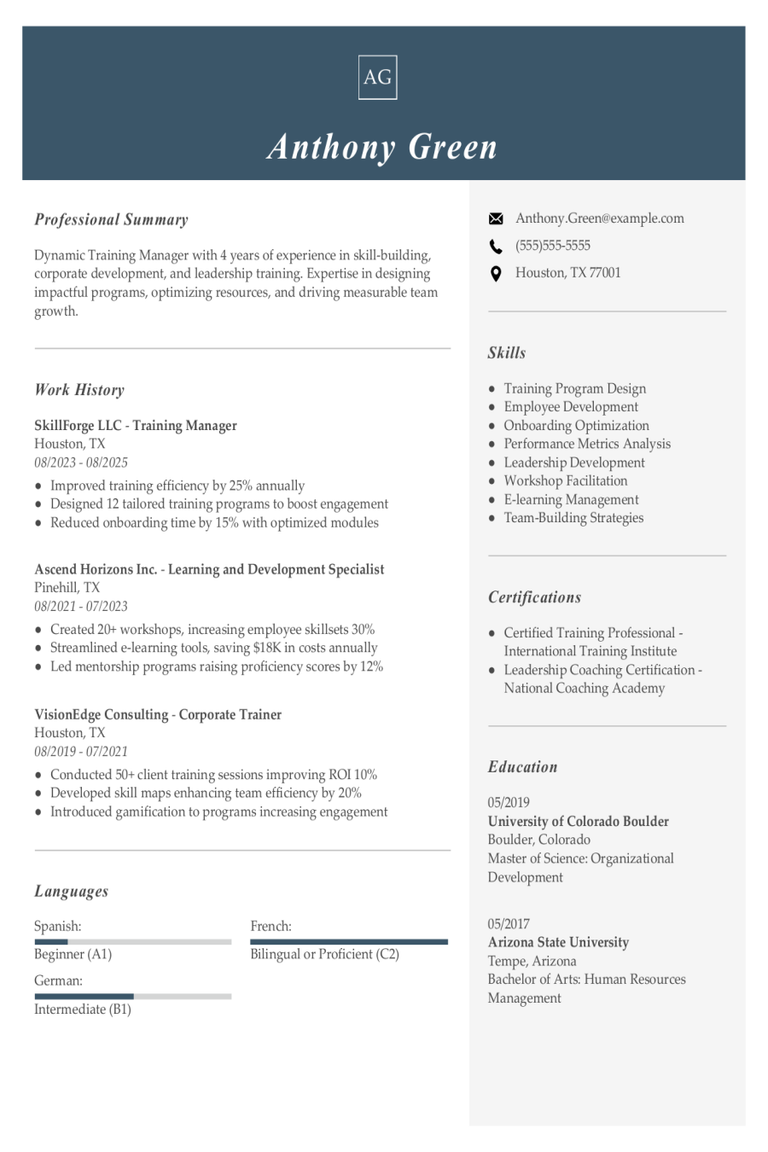
Training Manager Resume Examples & Templates for 2025
Discover how training managers showcase their skills in leading workshops and improving employee performance on their resumes. Our examples and tips will help you craft a resume that stands out
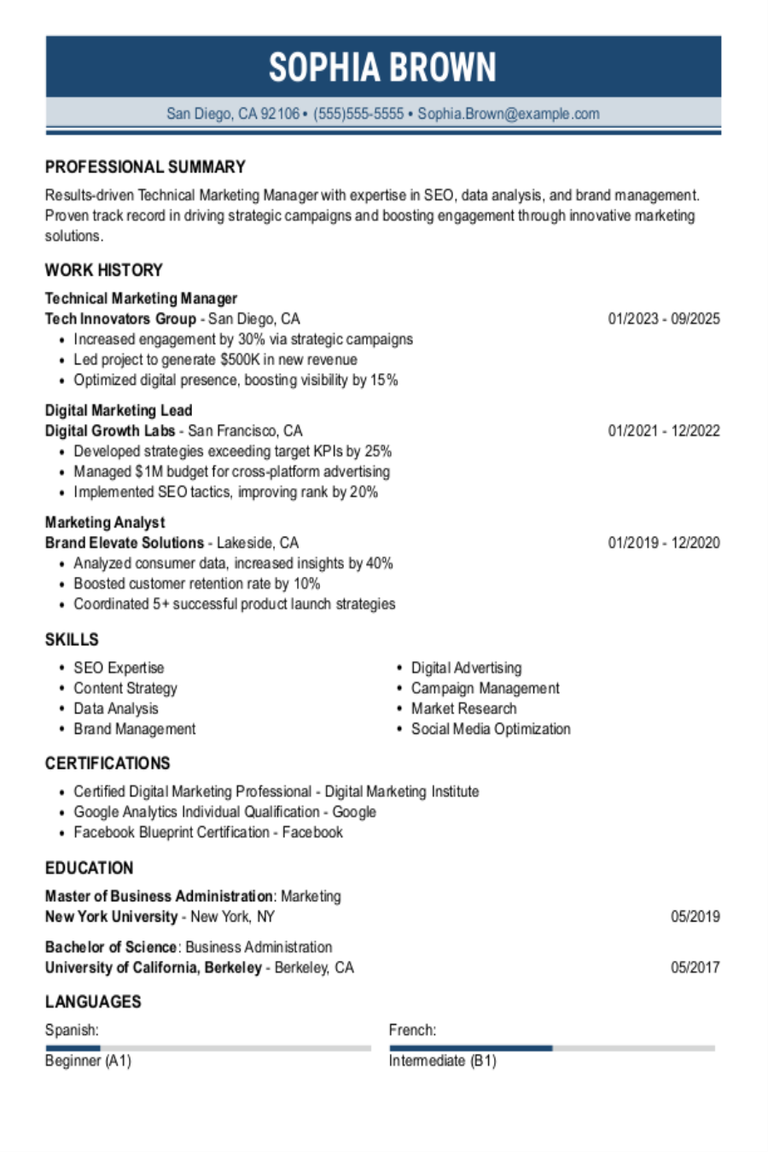
Technical Marketing Manager Resume Examples & Templates for 2025
Discover how to craft a technical marketing manager resume that shines. Learn to highlight your tech-savvy skills, marketing strategies, and project successes effectively.Build my resumeImport existing resumeCustomize this templateWhy this
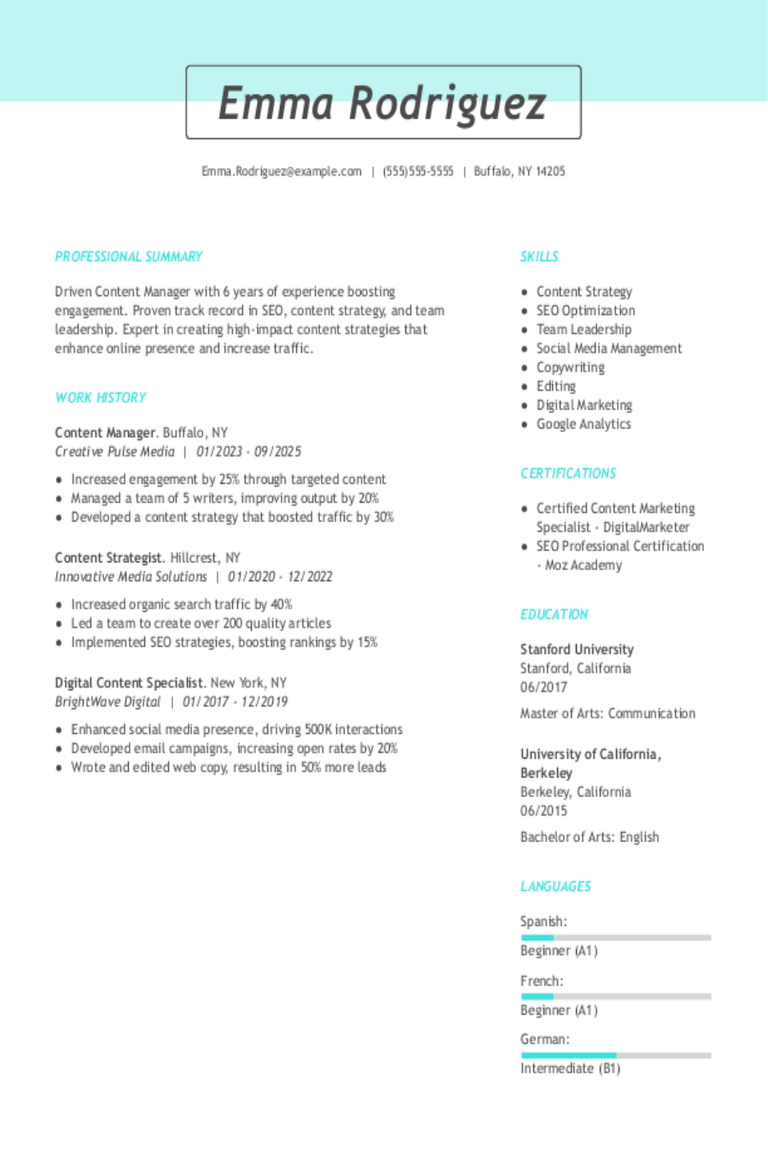
Content Manager Resume Examples & Templates for 2025
Browse content manager resume examples to see how to highlight your experience organizing, creating, and sharing engaging materials across platforms. These examples and tips help you showcase creativity, leadership, and
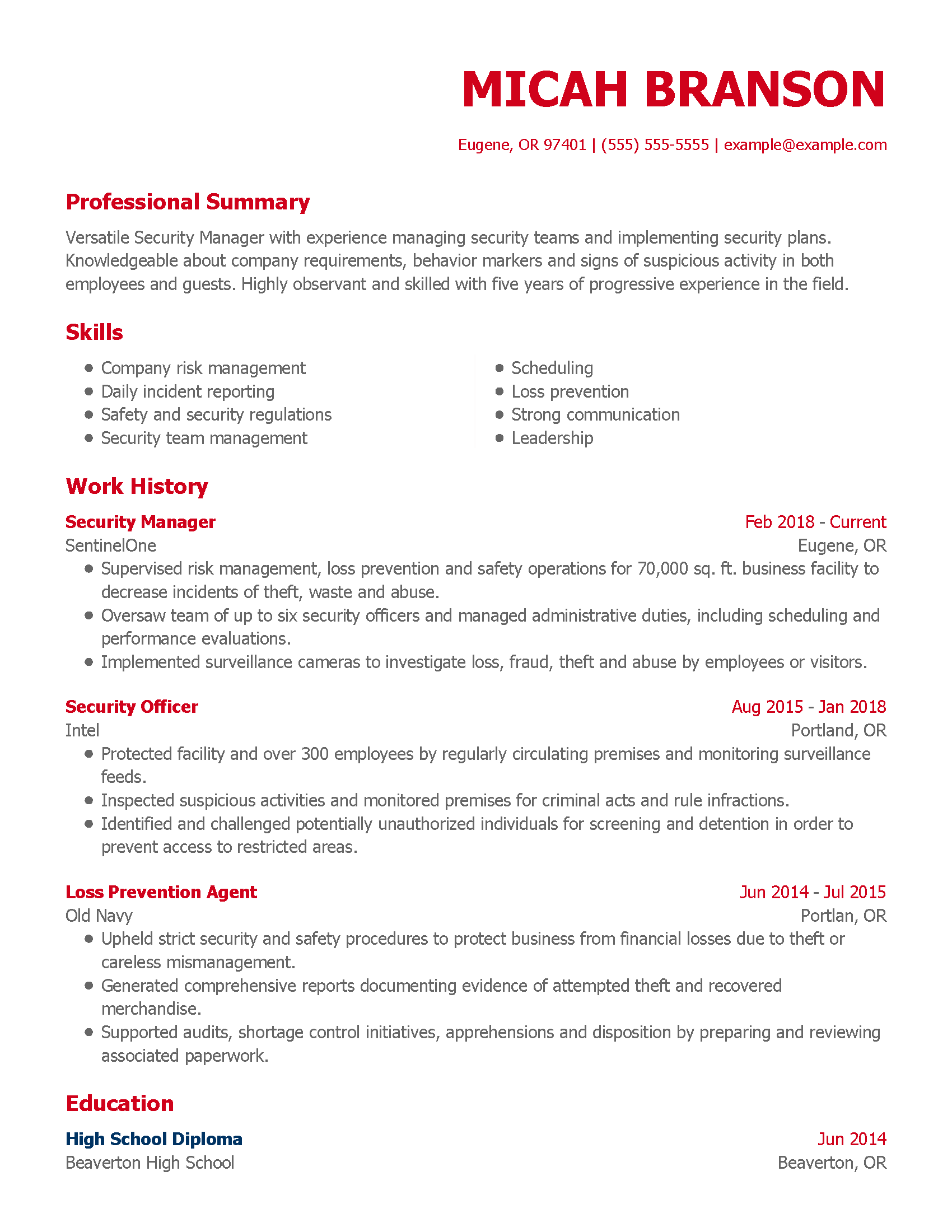
Security Manager Resume Examples & Templates for 2025
Explore security manager resume examples that showcase leadership, emergency response, and risk management. Get tips to highlight your skills and experience in keeping people and property safe.Build my resumeImport existing
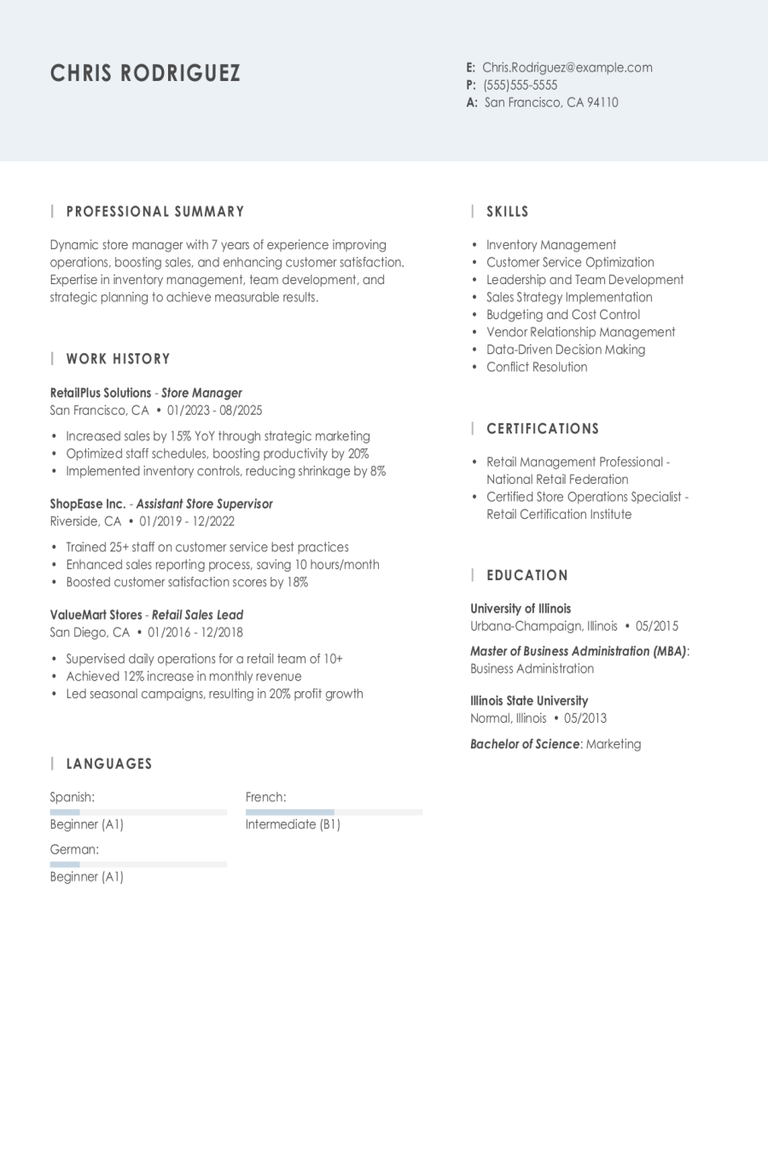
Store Manager Resume Examples & Templates for 2025
Browse store manager resume examples to see how to highlight your experience leading teams, managing inventory, and boosting sales. These examples and tips can help you highlight leadership and organization
